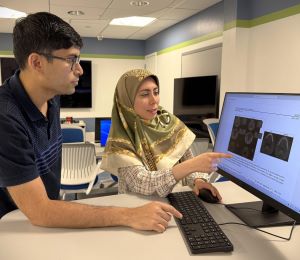
Dr. Mina Mahdian (Prosthodontics and Digital Technology) and Dr. Prateek Prasanna (Biomedical Informatics) have been awarded a prestigious 2-year $301,978 Multi-Principal Investigator (MPI) R03 grant from the National Institute of Dental and Craniofacial Research (NIDCR). Their project focuses on developing AI-driven approaches to identify cardiovascular risk through dental imaging.
The collaboration between Drs. Prasanna and Mahdian began at a Biomedical Informatics bootcamp, part of the Stony Brook Institute for Engineering-Driven Medicine’s series. Recognizing the opportunity to bridge imaging science and dental health, they secured an Office of the Vice President for Research (OVPR) seed grant that laid the foundation for this NIH-funded project.
Their research seeks to unlock the diagnostic potential of cone beam computed tomography (CBCT), a dental imaging modality. While commonly used to evaluate dental structures, CBCT often reveals incidental findings such as vascular calcifications — early indicators of systemic diseases like cardiovascular disease, diabetes, and renal disorders. Unfortunately, these signs are frequently overlooked due to limited training and lack of integration with broader health systems.
“This is about turning a routine dental scan into a window for early detection of systemic disease,” said Dr. Prasanna. “Our goal is to support dental professionals with AI tools that can flag these early signs and enable timely referrals for medical evaluation.”
What makes this initiative particularly unique is its interdisciplinary collaboration. The project brings together experts from the School of Dental Medicine and the College of Engineering and Applied Sciences at Stony Brook University—demonstrating how cross-disciplinary research drives innovation in precision health.
By integrating CBCT imaging features with dental record risk factors—such as smoking, diabetes, obesity, and cholesterol—the team aims to create a predictive tool to help dentists identify patients at high cardiovascular risk.
“This work aligns directly with NIDCR’s 2030 vision of connecting oral and overall health using data science,” said Dr. Mahdian. “It also reinforces the expanding role of dentistry in preventing systemic diseases.”
The project's outcomes could lay the groundwork for larger, multi-center studies and translational research that redefines dental imaging’s role in preventive medicine.

